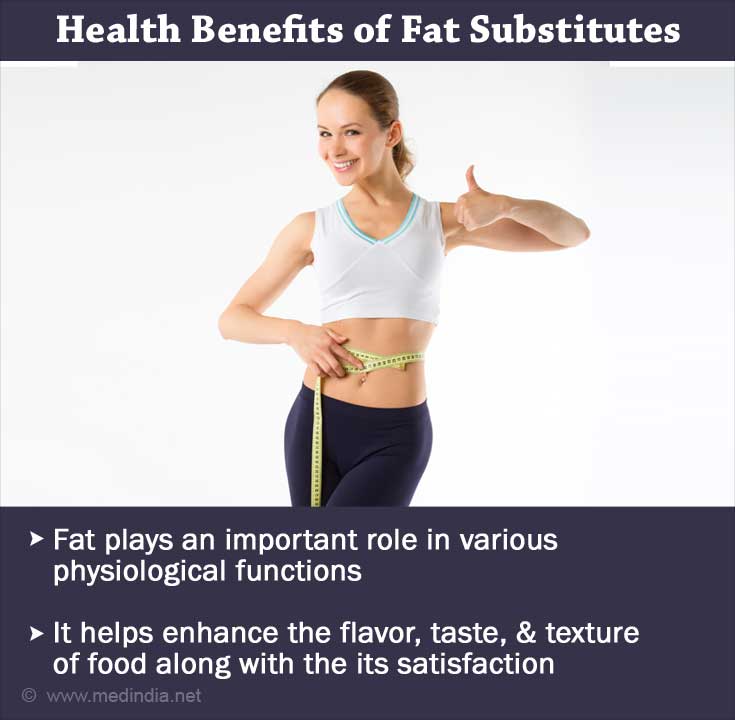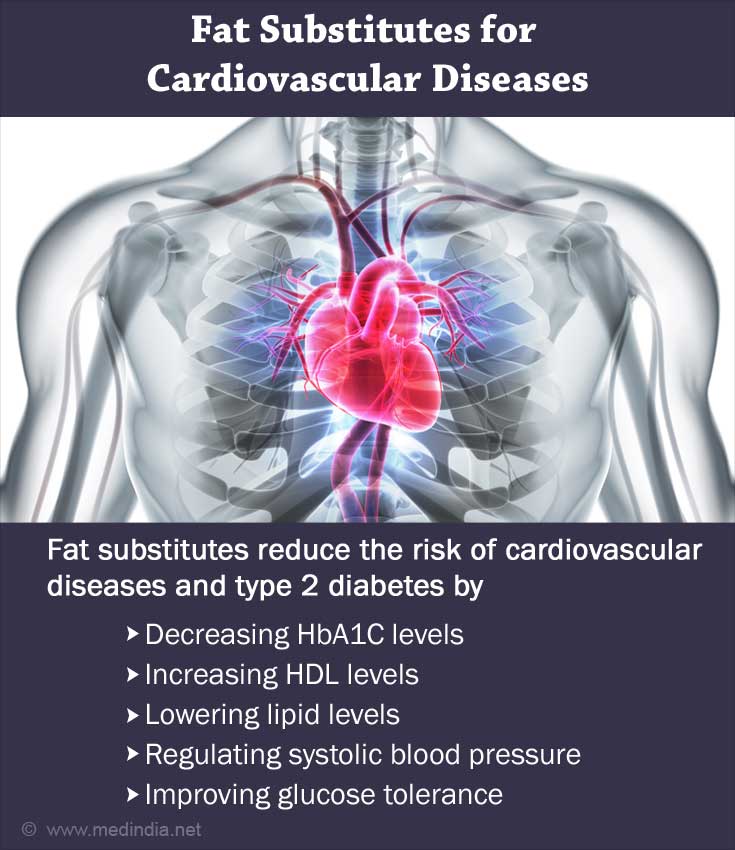- Calorie Control Council - (https://caloriecontrol.org/)
- Fat Substitutes and Health - (https://www.ahajournals.org/doi/full/10.1161/01.cir.0000019402.35632.eb)
What are Fat Substitutes?
Fear of getting fat stops people from eating butter, cream, oil, ghee and fried foods because fat is associated with weight gain, coronary heart disease and diabetes.
Contrary to popular perception, fat plays a role in important physiological functions. It helps to enhance flavor, taste and texture to food and provides satisfaction.

While fat is too vital a nutrient to completely rule out from your diet, consuming excess fat is detrimental to health.
Hence, fat substitutes have been created to provide taste and texture that are similar to high-fat foods, but with fewer calories.
Fat substitutes are ingredients, which are either chemically synthesized or derived from fats and oils through enzymatic modification. They mimic the role of fat in food: for example, provide texture to ice-creams or add moistness to baked products.
Types and Safety Concerns of Fat Substitutes
Since fat plays an important role in the taste of food, several ingredients are combined to replicate the taste of a full-fat snack or meal. It may include a blend of proteins, dextrins, maltodextrins, fiber, emulsifiers and flavoring agents.
An ideal fat substitute replicates all attributes of fat, simultaneously reducing the fat and calorie content of the food. Most fat substitutes must not be used for frying since they bind excessive water and denature or caramelize at high temperatures. However, they can be used for baking and retorting.
Fat substitutes possess physical properties of fat but cannot completely replace fat.
Based on nutrient source, fat substitutes are divided into three categories:
- Carbohydrate-based substitutes like cellulose, gums, modified food starches, maltodextrin, oats or wheat fiber, dried plum paste
- Protein-based substitutes like egg, milk, soy, gelatin
- Fat-based substitutes like caprenin, olestra, benefat
Carbohydrate-based fat substitutes duplicate thickness of fat and retain moisture. They are used as thickeners and stabilizers in baked goods, sauces, spreads, frostings, pureed fruits and soups. They provide between zero and four calories per gram. Most carbohydrate-based substitutes are generally regarded as safe (GRAS).
Protein-based fat substitutes made from milk, legumes, soy or egg replicate the creamy texture of fat and are used for preparing low-fat dairy products, baked goods, mayonnaise and salad dressings. Since protein-based substitutes are derived from dairy and eggs, they do not possess any health concerns. They are also used in frozen and refrigerated products. They provide one to two calories per gram and cannot be used for baking.
Fat-based substitutes provide fewer calories per gram than fat since the chemical structure of the fat has been altered. Caprenin, a substitute for cocoa butter in chocolate bars, provides 5 calories per gram.
Olestra, an FDA approved fat replacer, is made of table sugar and fatty acids from vegetable oils and comes closest to providing a taste of fat. It is used in fried savory snacks. The body cannot absorb olestra since digestive enzymes cannot break down such a large molecule. However, it affects, the absorption of fat-soluble vitamins and may cause cramps and loose motion.
Carbohydrate and protein-based fat substitutes have a negligible impact on digestion, absorption, or metabolism of other nutrients.
Fat substitutes can be a part of a healthy diet if eaten in small amounts.
Health Benefits of Fat Substitutes
Although people are aware of the risks of consuming excess dietary fat, people find it difficult to reduce their fat intake because fat makes food tasty and appealing. In such a situation, fat substitutes offer an ideal solution.
Promotes Calorie Control
The American Dietetic Association (ADA) believes that fat substitutes offer a safe and effective means to maintain the palatability of food while also promoting calorie control.
The health-conscious public will benefit most from the use of fat substitutes, which create a variety of rich and tasty low-fat foods without piling on the pounds.
Helps in Weight Loss
Eating reduced-fat foods reduces overall calorie intake eventually leading to weight loss. Fat substitutes have a positive impact on diet quality and help with weight loss and maintenance.
For example, salad dressings made with fat substitutes may increase consumption of vegetable and fruit salads.
Protein-based fat substitutes increase protein content in the diet, which is the mainstay of any weight loss diet. Dairy-based proteins add calcium, which also possesses weight-loss properties. Thus, protein-based fat substitutes offer a double bonanza to calorie-conscious eaters.
Reduces Risk of Non-Communicable Diseases
A fiber-based fat replacer like Mimex or Oatrim coupled with a healthy lifestyle is effective in combating obesity and the complications associated with it.
Additionally, they would provide benefits like decreased HbA1C, increased HDL levels, lowered lipid levels and systolic blood pressure and improved glucose tolerance, which would reduce the risk of cardiovascular diseases and type 2 diabetes.

Tips
While fat substitutes seem a good way to cut calories, do not mindlessly munch on low-fat foods since they contain ingredients, which replace the texture or flavor. Although the calorie content may be slightly lower in a fat-reduced product, it is important to watch portion size and calorie intake.
Choose products with less than three grams of fat per serving while buying low-fat products.






